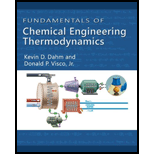
A)
Interpretation:
To plot the
Concept introduction:
An example of a binary system with constant pressure of vapor liquid equilibrium system is the mixture of n-hexane (1) and ethanol (2).
The experimental vapor liquid equilibrium data is given in Table (1).
| 351.45 | 0.000 | 0.000 |
| 349.15 | 0.010 | 0.095 |
| 346.35 | 0.020 | 0.193 |
| 340.55 | 0.060 | 0.365 |
| 339.05 | 0.080 | 0.420 |
| 334.95 | 0.152 | 0.532 |
| 332.55 | 0.245 | 0.605 |
| 331.85 | 0.333 | 0.630 |
| 331.50 | 0.452 | 0.640 |
| 331.25 | 0.588 | 0.650 |
| 331.15 | 0.670 | 0.660 |
| 331.40 | 0.725 | 0.670 |
| 331.60 | 0.765 | 0.675 |
| 332.30 | 0.898 | 0.710 |
| 333.35 | 0.955 | 0.745 |
| 336.65 | 0.990 | 0.840 |
| 339.85 | 0.994 | 0.935 |
| 341.85 | 1.000 | 1.000 |
Table (1)
An example of a binary system with constant temperature of vapor liquid equilibrium system is the mixture of tetrahydrofuran (1) and n-hexane (2).
The experimental vapor liquid equilibrium data is given in Table (2).
| 37.69 | 0 | 0 |
| 39.943 | 0.098 | 0.145 |
| 42.077 | 0.185 | 0.251 |
| 43.623 | 0.275 | 0.346 |
| 44.943 | 0.385 | 0.439 |
| 45.463 | 0.448 | 0.488 |
| 45.543 | 0.488 | 0.515 |
| 45.783 | 0.520 | 0.539 |
| 45.676 | 0.535 | 0.549 |
| 45.730 | 0.573 | 0.575 |
| 45.756 | 0.620 | 0.610 |
| 45.663 | 0.665 | 0.645 |
| 45.570 | 0.713 | 0.682 |
| 45.316 | 0.738 | 0.695 |
| 44.810 | 0.803 | 0.755 |
| 44.063 | 0.843 | 0.790 |
| 43.543 | 0.883 | 0.826 |
| 42.663 | 0.925 | 0.885 |
| 41.477 | 0.975 | 0.955 |
| 40.410 | 1 | 1 |
Table (2)
B)
Interpretation:
To identify in the
Concept introduction:
An example of a binary system with constant pressure of vapor liquid equilibrium system is the mixture of n-hexane (1) and ethanol (2).
The experimental vapor liquid equilibrium data is given in Table (1).
| 351.45 | 0.000 | 0.000 |
| 349.15 | 0.010 | 0.095 |
| 346.35 | 0.020 | 0.193 |
| 340.55 | 0.060 | 0.365 |
| 339.05 | 0.080 | 0.420 |
| 334.95 | 0.152 | 0.532 |
| 332.55 | 0.245 | 0.605 |
| 331.85 | 0.333 | 0.630 |
| 331.50 | 0.452 | 0.640 |
| 331.25 | 0.588 | 0.650 |
| 331.15 | 0.670 | 0.660 |
| 331.40 | 0.725 | 0.670 |
| 331.60 | 0.765 | 0.675 |
| 332.30 | 0.898 | 0.710 |
| 333.35 | 0.955 | 0.745 |
| 336.65 | 0.990 | 0.840 |
| 339.85 | 0.994 | 0.935 |
| 341.85 | 1.000 | 1.000 |
Table (1)
An example of a binary system with constant temperature of vapor liquid equilibrium system is the mixture of tetrahydrofuran (1) and n-hexane (2).
The experimental vapor liquid equilibrium data is given in Table (2).
| 37.69 | 0 | 0 |
| 39.943 | 0.098 | 0.145 |
| 42.077 | 0.185 | 0.251 |
| 43.623 | 0.275 | 0.346 |
| 44.943 | 0.385 | 0.439 |
| 45.463 | 0.448 | 0.488 |
| 45.543 | 0.488 | 0.515 |
| 45.783 | 0.520 | 0.539 |
| 45.676 | 0.535 | 0.549 |
| 45.730 | 0.573 | 0.575 |
| 45.756 | 0.620 | 0.610 |
| 45.663 | 0.665 | 0.645 |
| 45.570 | 0.713 | 0.682 |
| 45.316 | 0.738 | 0.695 |
| 44.810 | 0.803 | 0.755 |
| 44.063 | 0.843 | 0.790 |
| 43.543 | 0.883 | 0.826 |
| 42.663 | 0.925 | 0.885 |
| 41.477 | 0.975 | 0.955 |
| 40.410 | 1 | 1 |
Table (2)
C)
Interpretation:
To discuss the behavior of the system on the basis of Raoult’s law.
Concept introduction:
Raoult’s law expresses that the incomplete vapor pressure of every segment of a perfect blend of fluids is equivalent to the mixture of vapor pressure of the pure component and the mole portion in the blend
Negative deviation
When the adhesive forces between particles of different type are stronger than the cohesive forces between disparate atoms, the vapor pressure is less than the expected from the Raoult’s law. This is known as negative deviation.
Positive deviation
When the cohesive force between particles of same type is greater than the adhesive forces between atoms of different type, the extremity of dissimilarities leads both segments to escape the arrangement more effortlessly. In such case, the vapor pressure expected is more than that from the Raoult's law. This is called positive deviation.
Trending nowThis is a popular solution!

Chapter 10 Solutions
Fundamentals of Chemical Engineering Thermodynamics (MindTap Course List)
 Introduction to Chemical Engineering Thermodynami...Chemical EngineeringISBN:9781259696527Author:J.M. Smith Termodinamica en ingenieria quimica, Hendrick C Van Ness, Michael Abbott, Mark SwihartPublisher:McGraw-Hill Education
Introduction to Chemical Engineering Thermodynami...Chemical EngineeringISBN:9781259696527Author:J.M. Smith Termodinamica en ingenieria quimica, Hendrick C Van Ness, Michael Abbott, Mark SwihartPublisher:McGraw-Hill Education Elementary Principles of Chemical Processes, Bind...Chemical EngineeringISBN:9781118431221Author:Richard M. Felder, Ronald W. Rousseau, Lisa G. BullardPublisher:WILEY
Elementary Principles of Chemical Processes, Bind...Chemical EngineeringISBN:9781118431221Author:Richard M. Felder, Ronald W. Rousseau, Lisa G. BullardPublisher:WILEY Elements of Chemical Reaction Engineering (5th Ed...Chemical EngineeringISBN:9780133887518Author:H. Scott FoglerPublisher:Prentice Hall
Elements of Chemical Reaction Engineering (5th Ed...Chemical EngineeringISBN:9780133887518Author:H. Scott FoglerPublisher:Prentice Hall
 Industrial Plastics: Theory and ApplicationsChemical EngineeringISBN:9781285061238Author:Lokensgard, ErikPublisher:Delmar Cengage Learning
Industrial Plastics: Theory and ApplicationsChemical EngineeringISBN:9781285061238Author:Lokensgard, ErikPublisher:Delmar Cengage Learning Unit Operations of Chemical EngineeringChemical EngineeringISBN:9780072848236Author:Warren McCabe, Julian C. Smith, Peter HarriottPublisher:McGraw-Hill Companies, The
Unit Operations of Chemical EngineeringChemical EngineeringISBN:9780072848236Author:Warren McCabe, Julian C. Smith, Peter HarriottPublisher:McGraw-Hill Companies, The





